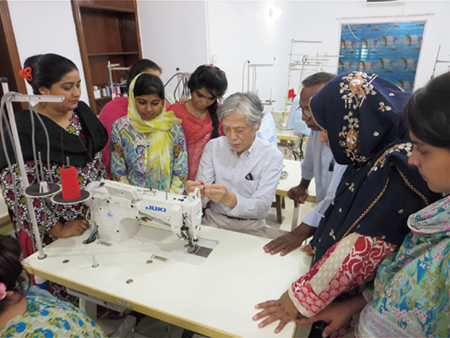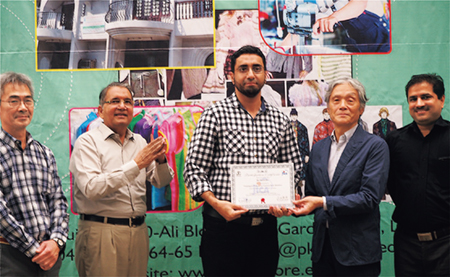Stories from the Field 07
Imparting Japan's Expertise in Productivity Improvement
– “KAIZEN” Aimed at Enhancing the Value of Pakistan's Apparel Products
Pakistan is a country of 195.4 million people, bordered by Afghanistan and Iran to the west, China to the north, India to the east, and the Arabian Sea to the south. It has large agriculture and textile industries, and it is the fourth largest producer of cotton in the world. The textile industry accounts for approximately 10% of the country's GDP, about 50% of the value of all goods exported, and around 40% of the workers employed in manufacturing, which shows the significance of this industry in Pakistan. However, Pakistan has had a major issue to cope with in this key industry for a long time. Most of the textile goods made in and exported from Pakistan are still low-technology and low-added-value home textiles such as bedspreads, sheets and towels. Pakistan is one of the world's largest producers of cotton, and yet, this advantage cannot be utilized for the following reasons.
At first, Pakistan was unable to meet worldwide demand for cheap and high-quality “finished products” because it did not focus on improving added value through processing before exporting, even though it is one of the world's largest producers of cotton. Also, it has been pointed out that Pakistan's strongly rooted traditional belief that women must play household roles has resulted in a shortage of female workers who can carry out the uniform and orderly work required in sewing.

Mr. Shoda teaching how to use an industrial sewing machine at a vocational school (Photo: Aya Fujita)
Given this background, the Project for Skill Development and Market Diversification of Garment Industry was launched in June 2016. The goal of this project is to improve the skills of individual workers on production lines to increase competitiveness and to equip all of factory members, especially those in the management, with the perspectives on production management, which means fostering awareness and knowledge towards enhancing quality. Therefore, under this project, technical assistance and instruction was provided to vocational schools in order to develop human resources in the apparel industry.
An expert, Mr. Yasuhiro Shoda plays a central role in this project based on his worldwide experience in supporting and leading seminars for developing apparel industry and factory productivity improvement projects. He describes the situation at vocational schools immediately after his arrival as follows, “After careful observation in the field, the first thing I noticed was that the school curriculums did not match the needs of Pakistan's apparel industry. I also found there to be little experience in making Western clothing and a lack of basic skills in technique training, including pattern making. And they did not understand the need for KAIZEN, even though it is now recognized around the world as a method for improving the environment on a production floor and for controlling quality, and especially 5S methodology (Sort, Straighten, Shine, Standardize, and Sustain) for quality improvement. What's more, even if taught, these approaches were not put into practice. This is why I had to repeatedly demonstrate firsthand and explain in detail to emphasize the importance of 5S.”

Presenting a completion certificate for instructor training at a vocational school (Photo: Aya Fujita)
One and half year has passed since the inception of this project, which spans the four-year period from June 2016 to May 2020. The instructor training is finally winding down, focused on 10 basic fields that each instructor must know, including textiles, dyeing, finishing work, quality control, etc. On the work floor, instructors began to teach students about the right attitude and discipline in addition to Shine, a fundamental tenant of 5S methodology. As a result, students began to clean equipment and carry out maintenance work daily. “Instructor training has not been completed, so there is still a long way to go in catching up with Japanese apparel training standards, but I do feel progress is being made each and every day. Pakistan still offers potential, especially today when many companies are relocating a production base to other ASEAN countries because payroll costs are soaring in China. I believe Pakistan will be competitive once it can create good quality products at a low cost. Towards this end, it is essential that people in the industry learn how to plan and design to increase added value and to create a labor environment that makes it easier for women to participate. Our goal is to submit a policy proposal to the Ministry of Textile Industry in the final (fourth) year of this project,” says Mr. Shoda.
Currently, the development of the textile industry in Pakistan is one of the important issues involving both the public and private sectors. The country has established the ambitious goal of doubling its current export value of $13 billion by the year 2019. The steady support of Mr. Shoda and others at this time of major change in Pakistan will encourage the people who will work to make this goal a reality.
<< Previous Page Next Page >>
Main Text | Statistics and Reference Materials | Stories from the Field | Master Techniques from Japan to the World | ODA Topics
